
The word color or colour is derived from the Latin celare which means “to conceal.” Hue, a synonym for color has its meaning in old English hiw, meaning form or appearance. In our earthly experience color is universal and is the most descriptive of the human condition. Are you feeling blue today? Are you green with envy? Did you get angry and see red?
What of the actual visual effect or color? There have been many documented cases of experiments with color and behavior. For example, in an air conditioned factory that had a steady temperature of 72 ° many employees complained of feeling cold. Some even put on jackets even when the temperature was raised to 75°. A color consultant suggested that the walls be painted orange. After that was done the employees complained the 75° temperature was too high. Once the temperature was reduced back to 72°, everyone was happy. In another example showing how a switch from black and white visuals to color visuals affects memory retention, a US college professor found that when he substituted green slides for black and white, test scores rose as much as 40%. Further, red and green slides produced scores twice as high and black and white and red and green on a blue background increased scores by 30%.
Everything that exists may be expressed in terms of color, since color is just another name to describe energy or spirit from which everything is composed. ~ Zolar
The Ancient Mind conceived of everything in the world as consisting of the four elements earth, air, fire and water. Earth was said to be blue, air, yellow; fire, red; water, green. Ancient civilizations assigned colors to their various gods and goddesses. For example in Ancient Egypt, Osiris was green; Horus, white; Set, black; Isis had a garment of many colors. In Hinduism, Brahma is often represented as red or golden; Vishnu is clad in yellow; Shiva, the destroyer is black. The Druids of Britain and Gaul wore colored garments according to division – The Ovate wore green (the color of instruction and learning); the Bard wore blue (symbolizing harmony and truth); those of high stature the Ministers, wore white (symbolizing the purity of the sun). These three colors, green, blue and white, are the exact same designations used by the Greeks in reference to Atlantis. (Could Atlantis be more than a myth and could these colors suggest that the Druids were descended from migrated Atlanteans?) For the Ancient Hebrews, the colors red, blue, purple and white were all symbols of God. Sin, love and sacrifice were connected with red, glory with blue, splendor and dignity with purple and purity and joy with white. In primitive Christianity, the Holy Trinity is associated with blue (the father), yellow (the son) and red, the Holy Spirit. I traditional art, Christ is often portrayed wearing a purple robe symbolic of suffering and endurance before his Crucifixion. Much of Christian art also portrays the various saints in green robes with a gold or yellow nimbus surrounding their heads.
According to the Ancient Egyptians, there were four races of humans: red, yellow, black and white. Purple not brown was the color of the Earth. The floors of the temples often were painted in greens and blues symbolizing the River Nile from which all life was thought to originate. The Tibetans who viewed life from high in the mountains believed the north to be yellow, the south blue, the east white and the west red. In China, the heroic guardians assigned to compass points also had “color.” Mo-li Shou, the guardian of the north has a black face, Mo-li Hung, who guards the south, a red face, Mo-li Ch’ong who guards the east, a green face and Mo-li Hai who guards the west a white face. For many Native American Tribes, the colors red, yellow and black are considered masculine while white, blue and green are feminine.
Everywhere we look in history and the development of civilizations we find consistent use of color, in some cases even unconscious use. That leads us to how color can be applied personally to our everyday lives. Most people are familiar with the idea that everything that exists in the Cosmos is made up of atoms and molecules. In the still controversial work of color investigator Dinshah P. Ghadiali many correlations have been made. Some of these refer to the human body and how and what we eat. This thinking follows unusual lines but it very suggestive of the connection of the particular colors we surround ourselves with and even digest with the state of health. Here are some interesting excerpts:
ORGANS
Red – Liver
Orange – Thyroid, lungs
Yellow – Nerves, digestive system
Lemon – Thymus
Green – Pituitary
Turquoise – Skin
Blue – Pineal
Indigo – Parathyroid
Violet – Spleen
Magenta – Heart, kidneys, reproductive system
VITAMINS
A – Magenta
B1 (thiamine) – Turquoise
B2 (riboflavin) – Indigo
B6 (pyridoxine) – Orange, Purple
B12 (cobalamin) – Purple, Green
Biotin – Scarlet
Choline – Orange
Inositol – Turquoise
Folic Acid – Blue
Niacin – Violet
Niacinamide – Indigo
Pantothenic acid – Violet
PABA – Turquoise
B15 9Pangamic acid) – Purple
B complex – Magenta
C
- Rose hips – Violet
- Bioflavinoids – Orange
- Rutin – Violet
D – Orange
E – Green
MUSICAL NOTE AND FREQUENCY
G-392 – Red
G-392 and D-587 – Scarlet
A#-466 – Yellow
C-523 – Green
A-440 – Orange
C#-554 – Turquoise
D-587 – Blue
A#-466 and E-659 – Purple
E-659 – Violet
G-392 and E-659 – Magenta
D#-622 – Indigo
B-494 – Lemon
Have some fun – here is a listing of food colors. To deterimine your color hunger you will need to construct a grid of paper with 12 color blocks, red, orange,scarlet, green, yellow, blue, purple, turquoise, magenta, indigo, violet and lemon. Using a pendulum go through each color for a yes or no as to whether you need that color food for the day.
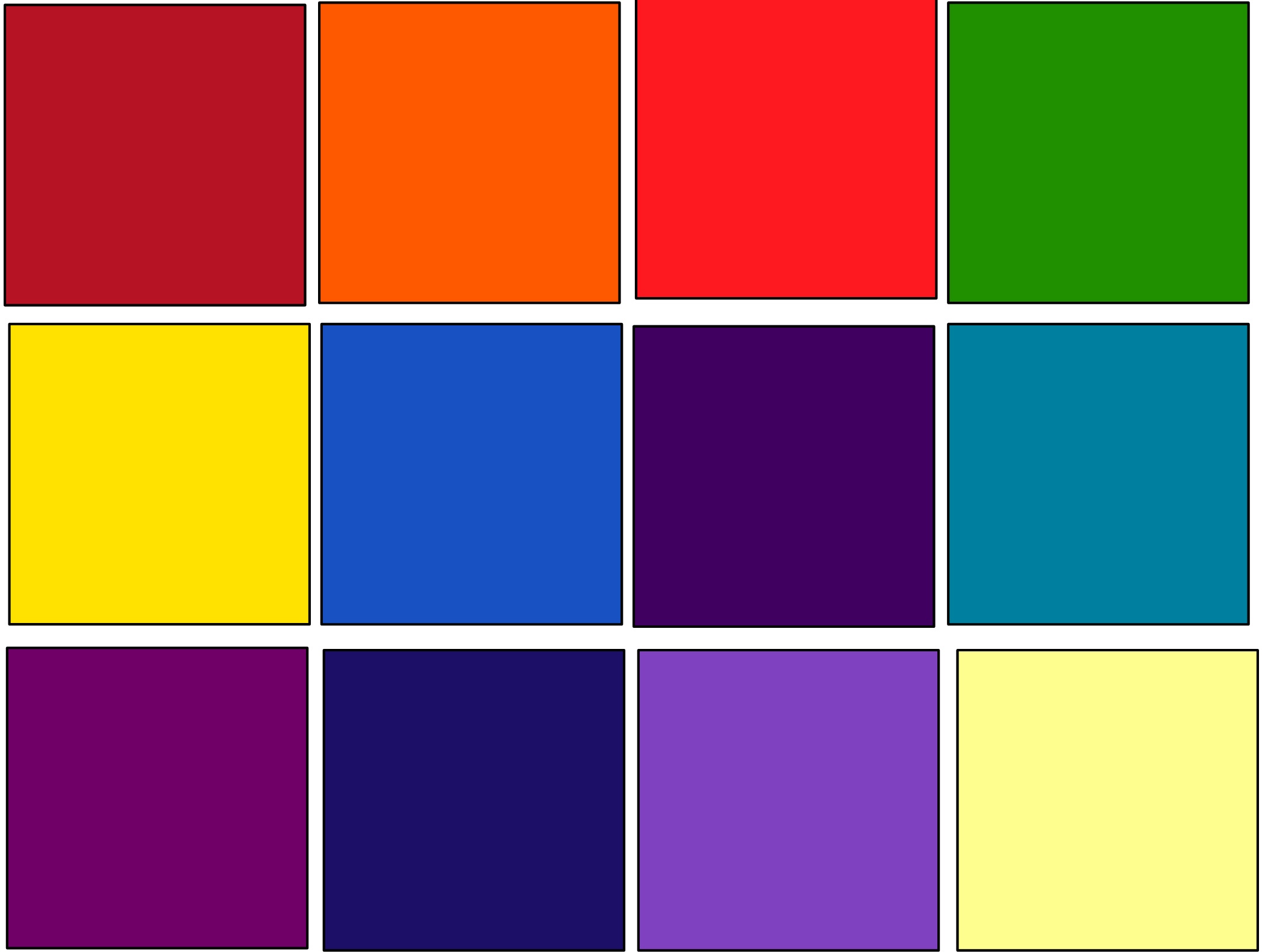

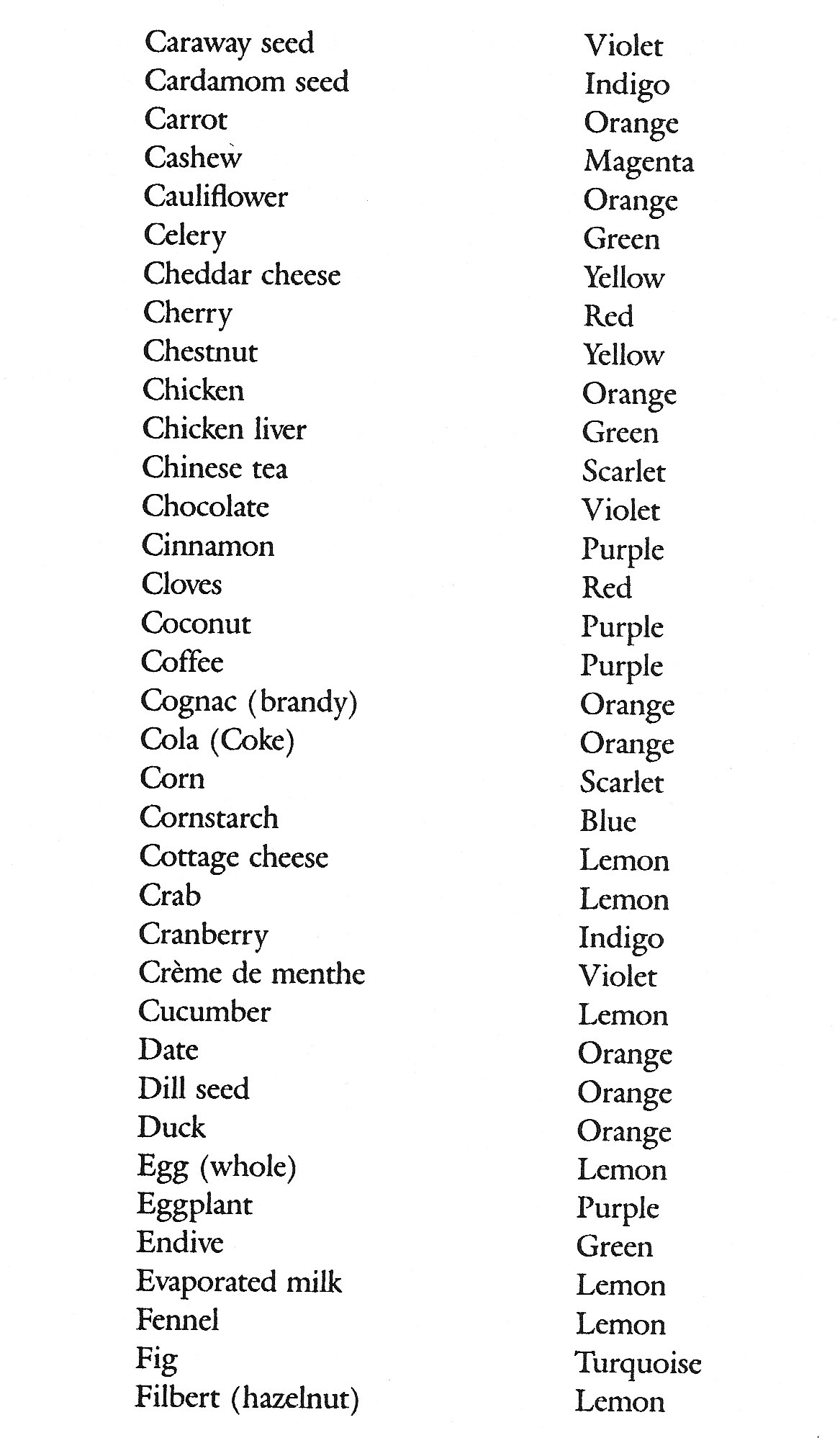

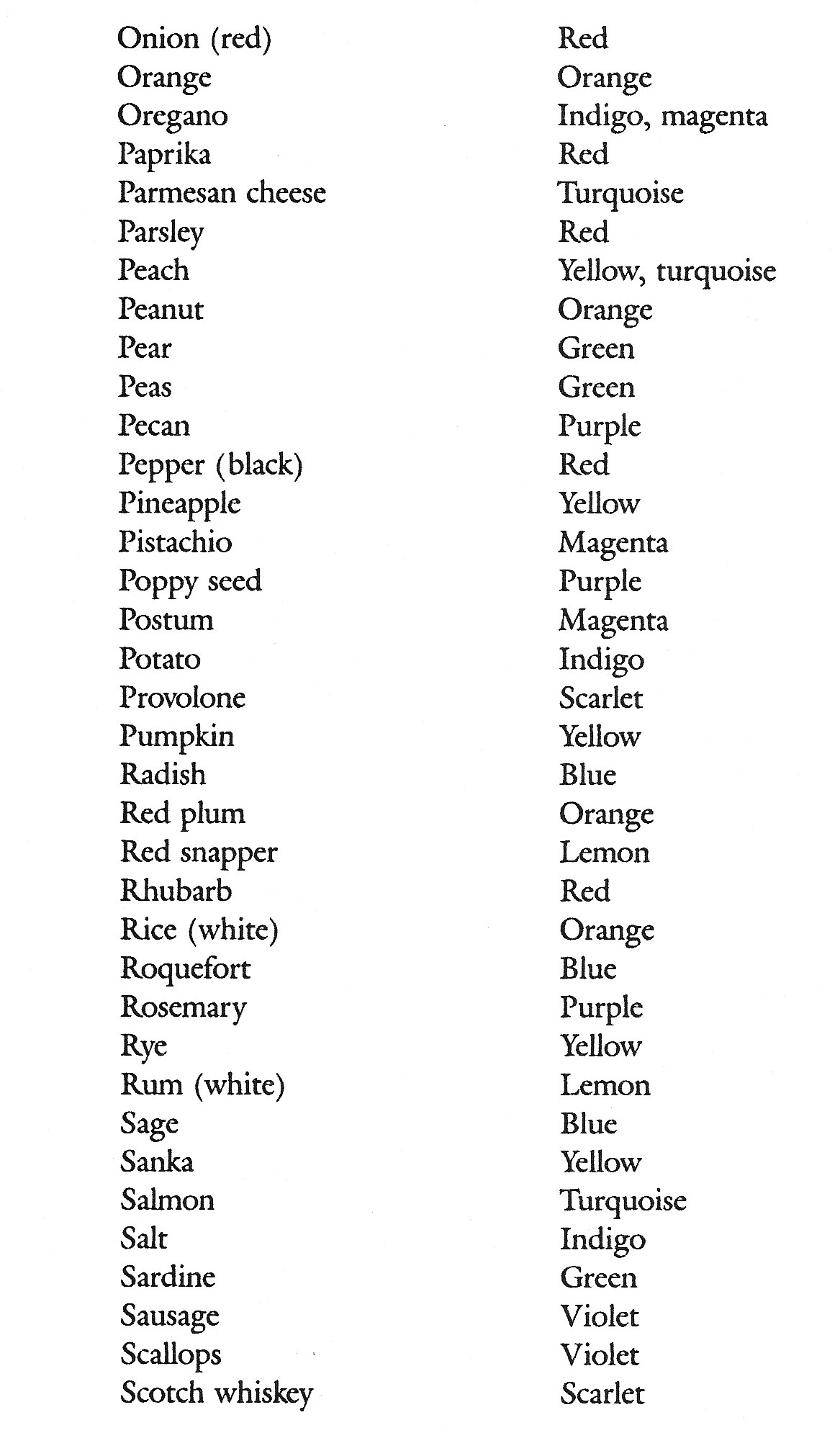
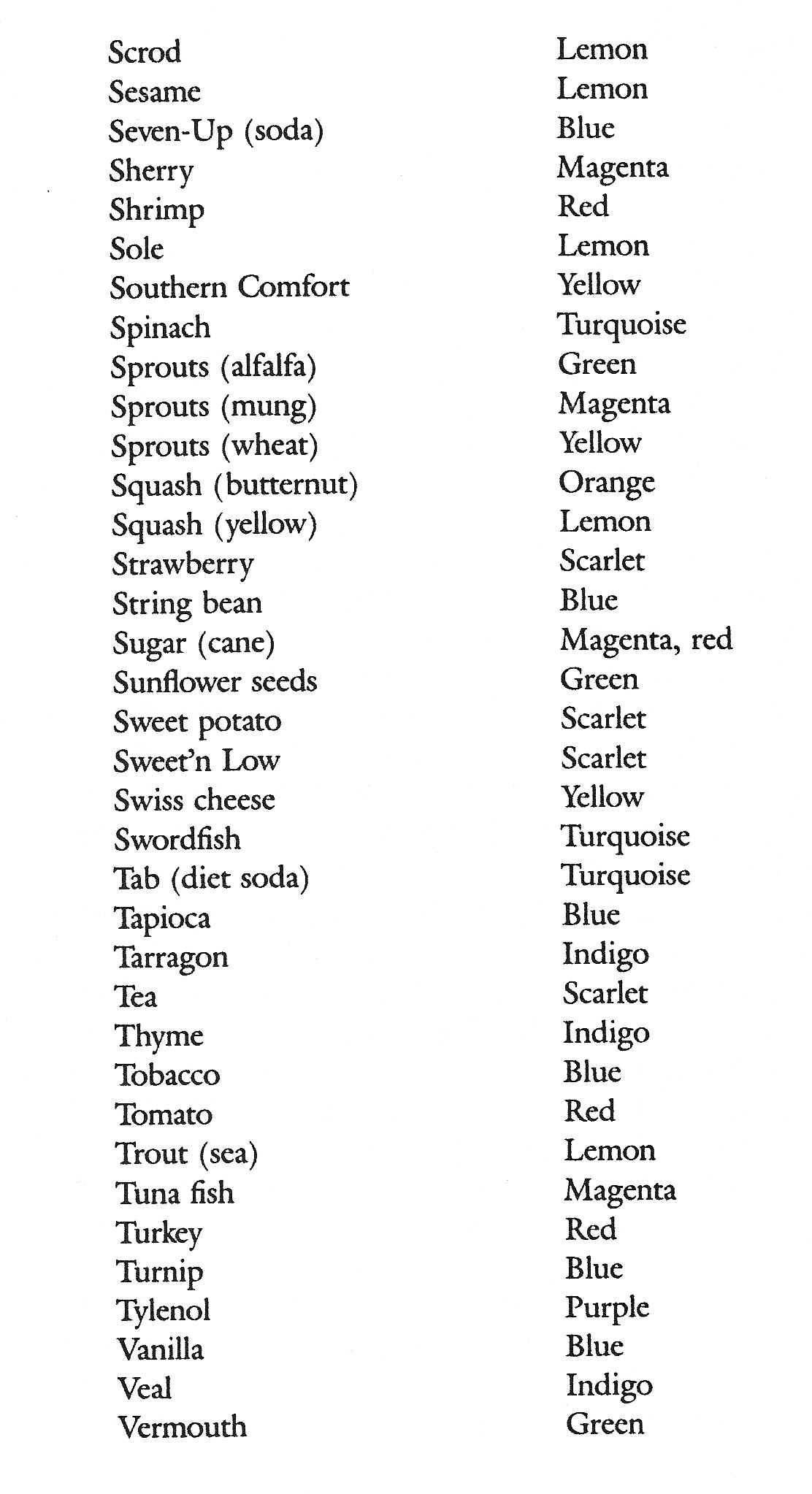
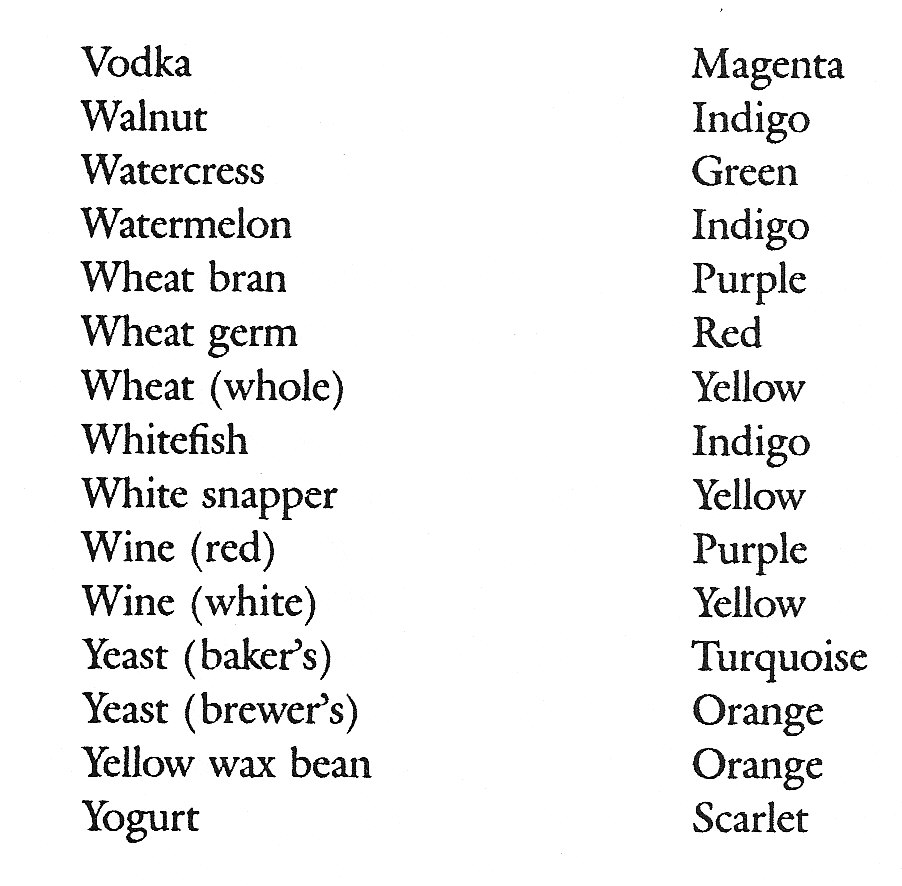
This rehash from Zolar’s Magick Book of Color
COLORS, WAVES, AND WAVELENGTHS ~ OH MY~!!!
Cool Info
Thanks ,very interesting 🙂